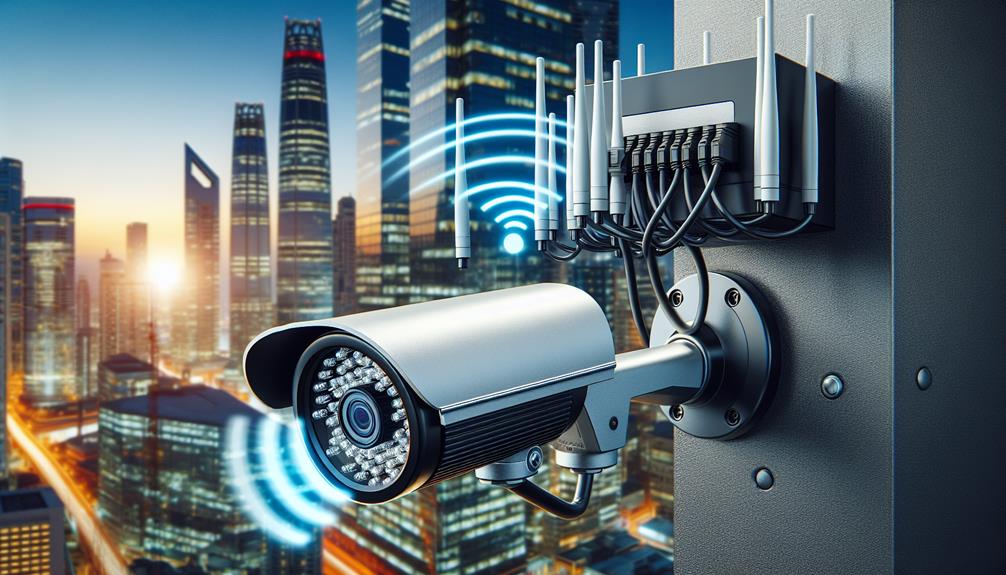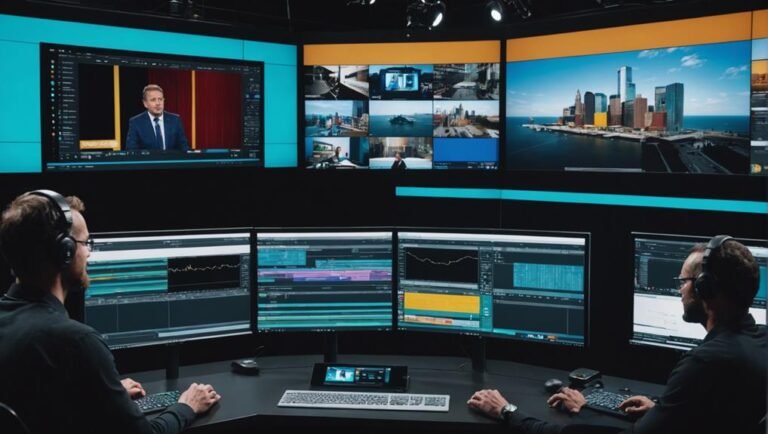When choosing between analog CCTV cameras and IP cameras, consider key differences. Analog CCTV cameras send video signals to a DVR and are more affordable initially but offer lower image quality and complex setups. IP cameras provide higher resolutions, easier installations with Power over Ethernet (PoE), and better low-light performance. They can be more expensive upfront but offer remote access, better scalability, and enhanced security features. IP systems are future-proof and readily integrate with modern technology. If you want to understand more about costs, security, and installation specifics, there’s plenty more to uncover.
Basic Overview
When comparing analog CCTV cameras to IP cameras, it’s important to understand their fundamental differences in technology and functionality. Analog CCTV cameras transmit video signals as analog waves, which means they convert the video signal into electronic pulses. These signals are then sent to a DVR (Digital Video Recorder) where they’re compressed and stored. Analog systems are typically simpler and less costly upfront. However, they may come with limitations that you should be aware of.
IP cameras, on the other hand, are digital from the get-go. They capture video footage and immediately convert it into digital data. This data can be transmitted over a variety of networks, including the internet. You can easily access and manage these cameras remotely, offering you greater flexibility and control. IP cameras often come equipped with features like encryption, which enhances the security of your data.
If you value freedom and the ability to adapt to future technological advancements, IP cameras offer a robust, scalable solution. Unlike their analog counterparts, they integrate seamlessly with modern devices and software, making them a more versatile option for your security needs.
Image Quality
The image quality of IP cameras generally surpasses that of analog CCTV cameras, offering higher resolution and clearer video footage. If you’re someone who values freedom and flexibility, IP cameras give you the liberty to see every detail, whether it’s a wide area or a close-up. With resolutions reaching up to 4K, IP cameras capture crisp, detailed images, making it easier to identify faces, license plates, or any vital details you need.
Analog CCTV cameras, on the other hand, often struggle to offer the same level of clarity. Their lower resolution means that the image quality can be grainy and less reliable, especially when zooming in. This can be a significant drawback if you’re aiming for precise monitoring and security.
Additionally, IP cameras excel in low-light conditions. Many models come with advanced features like infrared night vision and wide dynamic range (WDR), which guarantee clear images even in challenging lighting. Analog cameras typically lack these sophisticated capabilities, further limiting their effectiveness.
Installation Process
While image quality is a significant factor, the installation process also plays a crucial role in choosing between analog CCTV cameras and IP cameras. If you crave ease and flexibility, you’ll find that the installation methods differ substantially.
Analog CCTV cameras require a complex setup involving coaxial cables, DVRs, and power supplies. You’ll need to run multiple cables for video and power, and it can get messy if you’re covering a large area. However, the process is straightforward if you follow a consistent layout.
On the other hand, IP cameras offer a more streamlined installation process. With Power over Ethernet (PoE) technology, you can use a single cable for both power and data. This not only reduces the number of cables but also simplifies troubleshooting. Plus, IP cameras can connect wirelessly, giving you even more flexibility in placement and reducing the need for extensive wiring.
Therefore, if you’re looking for a hassle-free, scalable setup, IP cameras are generally the better choice. They offer the freedom to place cameras almost anywhere and expand your system with minimal effort.
Cost Comparison
Choosing between analog CCTV cameras and IP cameras often comes down to comparing costs. If you’re watching your budget, analog cameras usually have a lower upfront cost. You can get these cameras and a DVR (Digital Video Recorder) for a fraction of what you’d spend on an IP camera system. Analog systems are straightforward, so you won’t need to invest heavily in high-end infrastructure.
On the flip side, IP cameras might seem pricey initially. The cameras themselves and NVRs (Network Video Recorders) can cost more. However, don’t let the sticker price fool you. IP cameras often come with advanced features like higher resolution, smart analytics, and remote access capabilities. These features can save you money in the long run by reducing the need for additional equipment and labor.
Consider the total cost of ownership, including installation, maintenance, and upgrades. Analog systems might require more frequent replacements and can be harder to scale. IP systems, while more expensive to start, offer greater flexibility and future-proofing. Ultimately, weigh your immediate budget against your long-term needs and freedom to upgrade. This way, you’ll make the best choice for your security needs.
Scalability
When planning for future growth, you need to take into account how easily your surveillance system can be scaled. With analog CCTV cameras, you’ll face more challenges. Adding new cameras means you’ll need additional cables and possibly even a larger DVR or more DVRs to handle the increased footage. It’s a cumbersome process that can bog you down, especially if you’re looking for a quick and easy expansion.
On the other hand, IP cameras offer you the flexibility you crave. Adding new cameras to your system is much simpler. They connect over your existing network, so you won’t need to run new cables for each camera. Plus, modern NVRs (Network Video Recorders) are designed to handle numerous IP cameras, often with just a software update. This scalability lets you expand your surveillance system without the hassle and headache.
If freedom and future growth are important to you, IP cameras clearly have the edge. They allow you to adapt and scale your system effortlessly, ensuring you’re not bound by the limitations of analog technology. So, when it’s time to grow, you’ll be ready.
Remote Access
Remote access is a game-changer in modern surveillance, giving you the ability to monitor your property from anywhere. With IP cameras, you can tap into live feeds via your smartphone, tablet, or computer, ensuring you’re always in control. Analog CCTV cameras, on the other hand, usually require you to be on-site to view footage, limiting your flexibility.
Here’s a quick comparison:
| Feature | IP Camera | Analog CCTV Camera |
|---|---|---|
| Accessibility | Anywhere with internet | On-site only |
| Device Compatibility | Smartphones, tablets, PCs | DVR monitors |
| Real-time Alerts | Yes, via apps | No |
| Remote Management | Full control remotely | Limited to local access |
By choosing IP cameras, you’re not just investing in hardware; you’re investing in peace of mind. Imagine being on a beach, miles away from home, yet still able to check in on things with just a few taps. You’ll receive real-time alerts, making it easy to respond to any incidents promptly. Plus, remote management features let you adjust settings without being physically present.
Analog systems just don’t offer that kind of freedom. They’re tied down by their need for direct connection, and you lose out on the convenience and flexibility that IP cameras provide.
Security Features
A strong set of security features is essential in determining the effectiveness of your surveillance system. When comparing analog CCTV cameras to IP cameras, it’s clear that each offers different levels of protection. Analog cameras are straightforward but lack advanced security measures. They’re more susceptible to physical tampering since they often require direct access to the video feed. If someone cuts the cable, you’re out of luck.
In contrast, IP cameras bring a host of advanced security features that cater to your need for freedom and peace of mind. They offer encryption for data transmission, making it tougher for anyone to intercept or tamper with the video. Plus, IP cameras can come with user authentication, ensuring that only authorized users can access the footage. You can even set up notifications for any suspicious activity, so you’re always in the loop.
IP cameras also benefit from regular firmware updates that keep your system secure against new threats. Analog systems don’t offer this level of ongoing protection, leaving them vulnerable over time. With IP cameras, you’re investing in a more robust, future-proof solution that prioritizes your security and independence.
Frequently Asked Questions
How Do Analog and IP Cameras Handle Power Supply Requirements?
You’ll find analog cameras need separate power cables, while IP cameras can use Power over Ethernet (PoE). With PoE, you’ve got fewer cables and more flexibility, making setup easier and giving you the freedom you crave.
What Are the Typical Storage Capacities for Analog Vs. IP Camera Systems?
You’ll find that analog systems often use DVRs with limited storage, while IP camera systems generally offer more flexibility and larger capacities with NVRs or cloud storage. Choose based on how much freedom you need in storage.
How Does Weather Affect the Performance of Analog and IP Cameras?
Weather impacts both types of cameras, but IP cameras often handle harsh conditions better. Analog cameras can lose signal quality in extreme weather. You’ll want to choose a camera with weatherproof features for reliable performance.
Are There Any Compatibility Issues Between Older Systems and New IP Cameras?
When you explore the labyrinth of compatibility, yes, older systems and new IP cameras can clash. You’ll often need adapters or a complete overhaul. Embrace the challenge; it’s a step towards more freedom and control.
What Are the Maintenance Requirements for Analog Cameras Compared to IP Cameras?
You’ll find analog cameras need more hands-on upkeep like regular tape changes and cleaning. IP cameras, on the other hand, have fewer physical components to maintain but require software updates and network checks.



